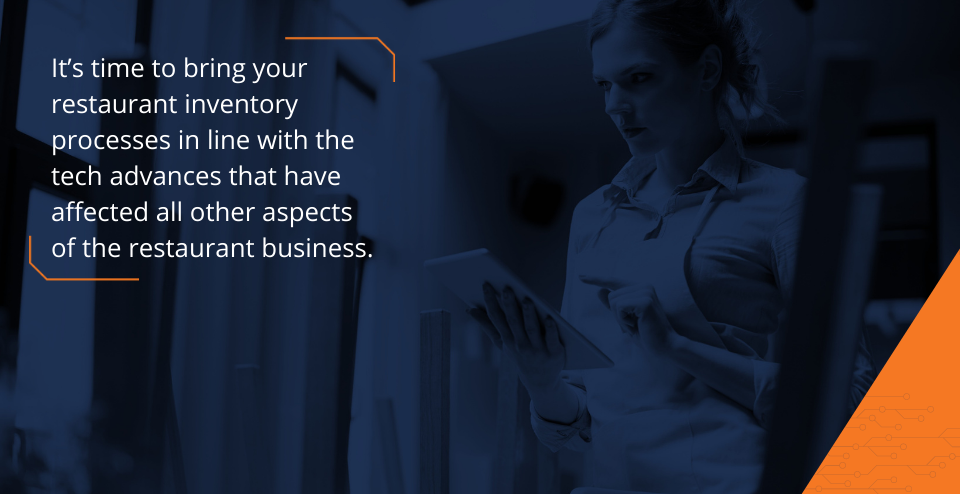It’s downright quaint to think of a time when you kept track of your inventory levels on a piece of paper. Even using an Excel spreadsheet for inventory today is likely to get you a derisive “okay boomer” from members of your team.
Archaic technology simply doesn’t cut it anymore, particularly when you consider rapid fluctuations to supply chain and pricing, the increased tech savviness of your employees, and the need to use the data derived from the inventory process to optimize your recipes for maximum profit potential.
The answer? Moving to an app-based inventory management system. But with so many options out there, how can you know what’s the right fit for your concept?
Be on the lookout for these 6 standout capabilities and you can be confident you have the right app for restaurant inventory across your concept.
1. Up-to-Date Data
You need confidence that the data entered into your inventory is up to date with the actual conditions within your restaurant.
If you’ve switched ingredient suppliers, team members should be made aware of that and have a means of comparing the two like-for-like products. If your supplier has changed from a 128-ounce version of a product to a 96-ounce version, that should be reflected in your inventory and all subsequent calculations.
And, if price fluctuates, that needs to carry over in real time, otherwise it’s impossible to track the cost of waste. This price tracking is more important than ever given recent struggles with the supply chain.
Let’s provide an example. Say the price of ketchup on July 1 is $2.00 (we’re using big round numbers and avoiding size specifications for ease of explanation). Ketchup lasts awhile, so it could stick around your supply space for months. Now, on October 1, the cost per ketchup is $3.00.
All subsequent inventory management should reflect that cost and follow the product all the way to plating and waste calculations. Because wasting 50 cents’ worth of ketchup from the cheaper order will have a much smaller impact than wasting ketchup from the inflated price you’re paying later in the year.
To properly determine your inventory and waste variance, this data needs to be up to date, otherwise you risk over-assessing or under-assessing your true cost of waste.
2. Editing Capabilities
Tied intrinsically to up-to-date data is the ability to edit that data within your inventory management tool.
Because prices and supplies can be so dynamic, your restaurant employees should have a means of editing this data on the fly and pushing those changes live to anyone else who would be reliant on that same information when calculating inventory.
You have a few options when it comes to granting permissions for editing. You could open the floodgates to let any user make changes, but we wouldn’t necessarily recommend that, as not all employees need to be given that level of control and authority.
Instead, you’re probably better off granting editing privileges to general managers and above. That way, you have someone at a location who can make adjustments as needed, but you’re still limiting the risk of a lower-level employee making an error.
You could also limit editing to persons at the franchisee or corporate level; if you do so, however, you should absolutely make sure they’re in constant communication with your general managers to know when prices change and what the conditions are for supplies and ordering on a store-by-store basis.

3. Back-Up Copies
Being able to save and back up your data on the fly is crucial in today’s restaurant environment. Because pricing is so dynamic, and because so many parties may input information at once, a snapshot, complete with a day and time stamp, can provide peace of mind.
If a system crashes, and you lose all current or historic inventory information, you’re going to lose a lot of time scrambling to regain those details. That time will cost you money, especially as you attempt to look back and determine what the state of your restaurant was days, weeks, and even months ago.
An app can provide back-ups, preferably in an off-site system, so that you can retrieve that information if there’s a crash.
4. Deployable to Multiple Systems
Another protection against crashes is to have the ability to deploy the inventory system to multiple computers, phones, and tablets, rather than keep it relegated to a single unit.
When your app is software-based rather than hardware-based, team members responsible for inventory can work from anywhere, from any modern machine, so long as they have their log-in credentials. This is yet one more way to support data security and business continuity when a system crashes, someone calls in sick, or any number of other issues arise.
5. Repeatable Processes
When software works well, you don’t think about it too much. It enables you to do your job without having to spend time fighting with the administration of the inventory app itself.
You want a restaurant inventory app that’s straight-forward, that shows you exactly what you need, and that makes management of your ingredients and supplies as easy as possible. Processes related to inventory should be documented and repeatable, so that you or anyone coming in to conduct that job will know precisely the steps to take to catalog current items and order new ones.
Which brings us to the last point…
6. Easy to Train New Hires
Your customer experience thrives on getting qualified individuals to work for and then stick with your restaurant. But sometimes even the biggest superstars will leave and take all that institutional knowledge with them.
This is a fact, and you need to prepare for it. It’s why inventory management is something that new hires and experienced managers alike should be able to pick up, following proven, documented steps to get the job done. Ideally, if your software is working well and your processes are solid, a new hire and a 30-year veteran should get the same results on your inventory management tool.
It should be easy to train people on your inventory software, and that process itself should be documented.
You’ll Manage
It’s time to bring your restaurant inventory processes in line with the tech advances that have affected all other aspects of the restaurant business.
If you’d like to know more about restaurant inventory management software, contact Decision Logic. We’ll show you how you can cut costs and boost profits with an app that works for your business rather than against it.





